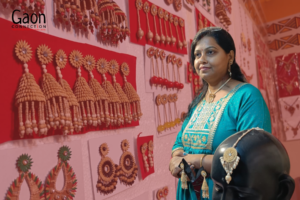Taruniya (Banka), Bihar
Draped in a bright pink sari with flowers on it, astride her scooty with a helmet tightly strapped along her jawline, Seema Hasda rode into an open patch of land, next to a farm of flowering sesame (til in Hindi). She got off and made her way to the wooden boxes that were lined up in neat rows.
A couple of Santhal tribal women from Taruniya and its neighbouring villages were already there tending to honey bees inside these boxes. Their faces well protected with nets hanging from the hats on their head, these women carefully pulled out frames from the boxes to check on the honey production.
“Soon the til flavour of honey will be ready for sale. I already have a quintal [100 kgs] of honey with me,” Seema smiled and said. “Last year, during the mahamari (pandemic), we sent about nine quintals of madh (honey) to Mumbai,” the ‘businesswoman’ and a mother of three, added.
Also Read: Rural women in Shahjahanpur are turning their lives around, one straw at a time
Mumbai, India’s financial capital, is about 2,000 kilometres away from Taruniya village in Banka district of south Bihar, where tribal women are part of an FPO (Farmers’ Producer Organisation) – Banka Madhu Farmers Producer Organisation – and are producing and selling honey far and wide.
The FPO was registered last year in 2020. Of its total 350 members, 200 are rural women like Seema. More than 60 per cent members of this FPO are tribal. Of the total annual honey production of 50 tonnes in Banka district, 40 tonnes is produced by this FPO alone.
A small beginning
Maria Tutu, a young Santhal from Taruniya village, who is the co-director of the Banka FPO, is instrumental in encouraging other rural women to take up bee-keeping.
It was two years ago, in 2019, that Maria took up bee-keeping with 15 boxes. She received technical guidance from the local Krishi Vigyan Kendra and financial support from the government. Today she has 65 boxes.
Also Read: From a domestic worker to Padma Shri awardee — here’s how Bihar’s Dulari Devi painted success
“These boxes, including the bees, were provided at a subsidy of 90 per cent. I had to contribute only ten per cent of the cost and decided to try my hands at the honey business,” the FPO co-director told Gaon Connection. “I felt that we women can do almost everything, be it farming, raising kids, looking after the aged and running the household. Then why can’t we run our own business,” asked Maria.
She encouraged four other women from her extended family and together these five Santhal women started their bee-keeping business in 2019. “I told these four women that if there was any loss, I would bear it. But we must give it a try. Aur ussi main humne baaze mar li [and we turned victorious],” said Maria, her eyes shining.
Now, women from all the 15 households in Maria’s tribal village are into bee-keeping and earn a regular income by selling honey in a variety of flavours – sheesham, mustard, litchi, palash (Butea monosperma), mahua (Madhuca longifolia) and more. Not just in Taruniya, but women from several other villages of Banka district located near the Bihar-Jharkhand border are into bee-keeping and their business is growing fast.
“Right now the til crop is getting ready, hence there is til honey. By December, it will be time for mustard honey as farmlands will be covered with yellow flowers of the mustard crop,” informed Seema, who belongs to the neighbouring Sarlaiya village in Banka.
Also Read: Approaching winters are busy times for both bees and the bee-keepers
“From January to March is the best time for honey as during the spring season, there are multiple flowers, and honey production gets a boost. On an average, one honey box helps earn Rs 2,000-2,500 per year,” said the tribal woman who now has a total of 150 boxes.
“Last year, despite the pandemic and the lockdown, Banka district produced 50 tonnes [50,000 kgs] of honey. This year, if the season favours us, we will produce a lot more honey,” said Ripusudan Singh, CEO and co-director of Banka Madhu FPO. Himself a farmer from Bindi village of Banka, Singh has been working closely with the tribal women in the district to train them in bee-keeping and helping them access various government schemes and benefits.
When dreams take shape
Often, after finishing her daily household chores and helping her husband with farming on their small patch of land, Soni Murmu of Rasuiya village would sit at a corner of her house with a smartphone and open YouTube.
“I used to watch YouTube videos on bee-keeping and always wondered if I could take it up too to supplement the family income. But I wasn’t sure how,” Soni, whose husband is a labourer, told Gaon Connection. “Last year, before the national lockdown was announced, I got to know about a training programme on bee-keeping at the krishi centre. I attended it and felt confident enough to bring 50 boxes home,” she added. Soni was also provided these boxes at a subsidy of 90 per cent.
Also Read: Bamboo to boost livelihood of tribal women in Mirzapur, Uttar Pradesh
And ever since, it has been a sweet story. “Even during the lockdown, our work did not stop as flowering continued and the honey bees kept working. A large chunk of my honey was purchased by the local villagers and traders,” said Soni, who sells the honey at a rate between Rs 300 and Rs 500 a kilo.
“During the lockdown, my husband could not find any work and was at home. Thanks to my honey business, I was able to earn money and feed my family,” narrated Soni. “At present, I have sheesham honey and multi flower honey with me at my home,” she added.
Talking about her journey from being a homemaker to a businesswoman, the tribal woman, who has a son, said: “Initially I was scared about failing, but once I started dealing with honey bees, I gained the confidence. Now I am super confident and wish to buy more boxes,” she smiled.
Honey production and box movement
The tribal women in Banka have received bee-keeping boxes at 90 per cent subsidy. Each woman has paid only 10 per cent (Rs 500) of the box cost.
“Depending on the season and wind direction, per box honey collection is two to two-and-a-half kilos every 15 to 18 days,” Beena Murmu, a madhu palak (bee keeper) from Taruniya village, who has 20 boxes, informed Gaon Connection. “February and March are the best months for honey due to large scale flowering. In the monsoon, there is no production. Also, if there is purva hawa [east winds], we get 2.5 kilo honey per box. But pachiya hawa [west winds] lead to a decline of two kilos per box only,” she added.
Keeping in mind the seasons, these tribal women hire a tempo and some male labour to send their boxes to different areas where crops are flowering. “During the litchi season, we send boxes to Amarpur [about 50 kilometres away]. We hire labourers who travel with the boxes and harvest the honey,” said Seema. “We pay close to three hundred rupees per day to them,” she added proudly.
The district administration is helping these women expand their business. “We have identified a honey corridor, which passes through Purnea, Bhagalpur, Banka, Godda, and Dumka. By moving the boxes along this route, honey production can be boosted in six to seven months of a year,” Suharsh Bhagat, district magistrate of Banka, told Gaon Connection.
“Earlier honey production in Banka was limited to two to three months, but now this has been raised to six to seven months a year. We have trained marginalised tribal women in honey keeping and results are promising,” he added.
The state government is also promoting these products made by the rural women by helping them find new markets. “We have launched a web portal to sell products made by rural women and Jeevika didis. Through this portal, the women can directly sell to the consumers anywhere in India and get good margin and profit,” Balamurugan D, chief executive officer of Bihar Rural Livelihoods Promotion Society (popularly known as JEEViKA), told Gaon Connection.
Also Read: How often do you hear the buzzzzz now? Why can’t you find many beehives around?
Improved quality of life
It was during the pandemic, the villagers realised the importance of daily consumption of honey. “Honey helps ward off cold and cough. And corona is all about cold, cough and fever. So villagers started consuming honey regularly in the pandemic and this helped our sales too,” said Beena Murmu.
“People in my village daily consume honey by smearing it on roti [flat bread]. This is the change that the mahamari has brought about. We also consume it daily. Honey also provides relief from knee and joint pains,” said Sabina Murmu of Taruniya village, who has ten boxes.
The money these Santhal women are earning by selling honey is transforming their lives and those of their family members too.
“Since the beginning of the pandemic, my maalik [husband] has had no regular work. I was worried about my only son and his education. But now, with the income of my honey business, we plan to enrol our son into an English medium school,” said Soni Murmu.
Also Read: Rural women in Uttar Pradesh spin a banana yarn and earn themselves economic independence
Similar is the story of Sabina Murmu whose daughter studies in standard 9 in a residential school in Lucknow, Uttar Pradesh. “Only if our children study, will they succeed in life. I am funding my daughter’s education in an English medium school in Lucknow through my honey sale,” said the proud mother.
Seema Hasda has three children and her elder daughter also studies in a residential school. “My 15-year-old daughter wants to become a nurse. For her nurse training, I need to save money and the honey business is helping me do that,” she told Gaon Connection. “The scooty that I ride, I bought it from my earnings,” she said with pride and childlike excitement.
On being asked how much Seema herself has studied, she said: “I could study only till class 5, but I always wanted to do something of my own. Par koi rasta nahi tha. Madhumakkhi ne rasta dikha diya [there was no way, but then honey bees showed me the way],” she said, as she turned the key to her scooty bringing its engine to life and sped off, to chase some more dreams.


















